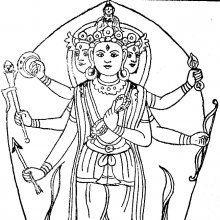Sitatapatraparajita, Sitātapatrāparājitā, Sitatapatra-aparajita: 1 definition
Introduction:
Sitatapatraparajita means something in Buddhism, Pali. If you want to know the exact meaning, history, etymology or English translation of this term then check out the descriptions on this page. Add your comment or reference to a book if you want to contribute to this summary article.
Images (photo gallery)
In Buddhism
Tibetan Buddhism (Vajrayana or tantric Buddhism)
Source: archive.org: The Indian Buddhist IconographySitātapatrāparājitā (सितातपत्रापराजिता) or simply Sitātapatrā refers to one of the emanations of Vairocana, as mentioned in the 5th-century Sādhanamālā (a collection of sādhana texts that contain detailed instructions for rituals).—Her Colour is white; she has six arms and three faces.—This goddess is called Sitātapatrā Aparājitā “the invincible Goddess with the white parasol” and should be distinguished from the other Aparājitā who has an entirely different form and is yellow in colour.

Tibetan Buddhism includes schools such as Nyingma, Kadampa, Kagyu and Gelug. Their primary canon of literature is divided in two broad categories: The Kangyur, which consists of Buddha’s words, and the Tengyur, which includes commentaries from various sources. Esotericism and tantra techniques (vajrayāna) are collected indepently.
See also (Relevant definitions)
Partial matches: Sitatapatra, Aparajita.
Full-text: Sitatapatra.
Relevant text
Search found 1 books and stories containing Sitatapatraparajita, Sitātapatrāparājitā, Sitatapatra-aparajita, Sitātapatrā-aparājitā; (plurals include: Sitatapatraparajitas, Sitātapatrāparājitās, aparajitas, aparājitās). You can also click to the full overview containing English textual excerpts. Below are direct links for the most relevant articles:
The Indian Buddhist Iconography (by Benoytosh Bhattachacharyya)
